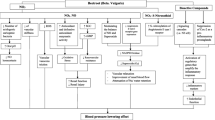Abstract
In rats rendered hypercholesterolemic by maintaining them on a cholesterol–enriched diet (0.5%) for 8 weeks, inclusion of spice principles – curcumin ((0.2%) or capsaicin (0.015%) or the spice – garlic powder (2.0%) in the diet, produced the expected hypolipidemic effect. Plasma cholesterol which was more than 200% that of basal control in hypercholesterolemic rats, was decreased by these dietary spice principles and garlic by 25–39%. Erythrocyte membranes of hypercholesterolemic rats were relatively enriched in cholesterol, which was about 120% of basal control, while membrane phospholipid was unaffected. This resulted in a significant alteration in cholesterol to phospholipid ratio of RBC membranes. Dietary curcumin, capsaicin and garlic were observed to counter this altered lipid profile of erythrocyte membranes in hypercholesterolemic situation by producing a significant 10–14% decrease in membrane cholesterol content.
As a result of alteration in membrane structural lipids, the structural integrity of RBCs was also affected. An examination of the osmotic fragility of erythrocytes in various groups, indicated that RBCs of hypercholesterolemic rats were relatively fragile compared to normal controls. Dietary curcumin, capsaicin and garlic appeared to correct this increased fragility of erythrocytes.
Similar content being viewed by others
References
Srinivasan K: Spices - valued for more than taste and flavour of foods. In: A. De Krishna (ed). Recent Trends in Spices and Medicinal Plants Research. Associated Publishing Co., New Delhi, 2000, pp 31–38
Govindarajan VS: Turmeric: Chemistry, technology and quality. Crit Rev Food Sci Nutr 12: 199–301, 1980
Srimal RC: Turmeric: A brief review of medicinal properties. Fitoterapia LXVIII: 483–493, 1997
Govindarajan VS, Satyanarayana MN: Capsicum - production, technology, chemistry and quality: Part-5 - impact on physiology, nutrition and metabolism, structure, pungency, pain and desensitisation sequences. Crit Rev Food Sci Nutr 29: 43–74, 1991
Surh YJ, Lee SS: Capsaicin, a double edged sword: Toxicity, metabolism, and chemopreventive potential. Life Sci 56: 1845–1855, 1995
Singhal PC, Gupta RK, Joshi LD: Hypocholesterolemic effect of T. foenumgraecum. Curr Sci 51: 136–137, 1982
Sharma RD: Hypocholesterolemic activity of fenugreek (T. foenumgraecum) - an experimental study in rats. Nutr Rep Int 30: 221–231, 1984
Jain MK, Apitz-Castro R: Garlic: A matter for heart. In: G. Charalambous (ed). Spices, Herbs and Edible Fungi. Elsevier Science, New York, 1994, pp 309–327
Carson JF: Chemistry and biological properties of onion and garlic. Food Rev Int 3: 71–103, 1987
Hussain MS, Chandrasekhara N: Influence of curcumin and capsaicin on cholesterol gall stone induction in hamsters and mice. Nutr Res 13: 349–357, 1993
Hussain MS, Chandrasekhara N: Effect of curcumin and capsaicin on the regression of pre-established cholesterol gall stones in mice. Nutr Res 14: 1561–1574, 1994
Suresh Babu P, Srinivasan K: Amelioration of renal lesions associated with diabetes by dietary curcumin in experimental rats. Mol Cell Biochem 181: 87–96, 1998
Suresh Babu P, Srinivasan K: Renal lesions in streptozotocin induced diabetic rats maintained on onion and capsaicin diets. J Nutr Biochem 10: 477–483, 1999
Cazana FJD, Puyol MR, Caballero JP, Jimenez AJ, Duarte AM: Effect of dietary hyperlipidemia-hypercholesterolemia on rat erythrocytes. Int J Vit Nutr Res 60: 393–397, 1990
Anon: Nutrient requirement of Laboratory Rat. In: National Research Council Sub-committee on Laboratory Animal Nutrition (ed). Nutrient Requirements of Laboratory Animals. Publ. No. 10, National Academy of Sciences, Washington D.C., 1978, pp 7–37
Bernhart FW, Tommarelli CM: A salt mixture supplying the National Research Council estimates of the mineral requirements of the rats. J Nutr 89: 495–500, 1966
Dacie JV, Lewis SM: In: Practical Haematology, 5th edn. Gurne & Shatton Inc., New York, 1975, pp 202–208.
Dodgi JT, Mitchell C, Hanahan DJ: The preparation and chemical characteristics of haemoglobin-free ghosts of human erythrocytes. Arch Biochem Biophys 110: 119–130, 1963
Rose HG, Oaklander M: Improved procedure for the extraction of lipids from human erythrocytes. J Lipid Res 6: 428–431, 1965
Folch J, Lees M, Sloane-Stanley GH: A simple method for the isolation and purification of total lipids from animal tissues. J Biol Chem 226: 497–509, 1957
Searcy RL, Bergquist LM: A new color reaction for quantitation of serum cholesterol. Clin Chim Acta 5: 192–197, 1960
Warnick GR, Albers JJ: A comprehensive evaluation of heparin-manganese procedure for estimating HDL-cholesterol. J Lipid Res 19: 65–76, 1978
Fletcher MJ: A colorimetric method for estimating serum triglycerides. Clin Chim Acta 22: 393–397, 1968
Charles J, Stewart M: Colorimetric determination of phospholipids with ammonium ferrothiocyanate. Anal Biochem 104: 10–14, 1980
Snedecor GW, Cochran WG: In: Statistical Methods. The Iowa State University Press, Ames, USA, 1967, p 100
Cooper RA: Abnormalities of cell membrane fluidity in the pathogenesis of disease. New Engl J Med 297: 371–377, 1977
Evans EA, Hochmuth RM: A solid - liquid composite model of the red cell membrane. J Membr Biol 30: 351–362, 1977
Pinter GG, Bailey RE: Anemia of rabbits fed a cholesterol containing diet. Am J Physiol 200: 292–296, 1961
Westerman MP, Wiggans RG, Mao R: Anemia and hypercholesterolemia in cholesterol fed rabbits. J Lab Clin Med 75: 890–892, 1970
Subba Rao D, Chandrasekhara N, Satyanarayana MN, Srinivasan M: Effect of curcumin on serum and liver cholesterol levels in the rat. J Nutr 100: 1307–1315, 1970
Sambaiah K, Satyanarayana MN: Hypocholesterolemic effect of red pepper and capsaicin. Indian J Exp Biol 18: 898–899, 1980
Kamanna VS, Chandrasekhara N: Effect of garlic (Allium sativum) on serum lipoprotein and lipoprotein cholesterol levels in albino rats rendered hypercholesterolemic by feeding cholesterol. Lipids 17: 483–488, 1982
Shinitzky M, Barenholz Y: Dynamics of the hydrocarbon layer wherein liposomes of lecithin and sphingomyelin containing dicetyl phosphate. J Biol Chem 249: 2652–2657, 1974
Chien S: Red cell deformability and its relevance to blood flow. Ann Rev Physiol 49: 177–192, 1987
Michalak J, Kadziolka A, Pruszkowiska R, Ledwozyw A, Madejezyk A: Compensatory mechanism in erythrocyte lipids in patients with atherosclerosis. Lipids 23: 476–480, 1988
Author information
Authors and Affiliations
Rights and permissions
About this article
Cite this article
Kempaiah, R., Srinivasan, K. Integrity of erythrocytes of hypercholesterolemic rats during spices treatment. Mol Cell Biochem 236, 155–161 (2002). https://doi.org/10.1023/A:1016199000149
Issue Date:
DOI: https://doi.org/10.1023/A:1016199000149




